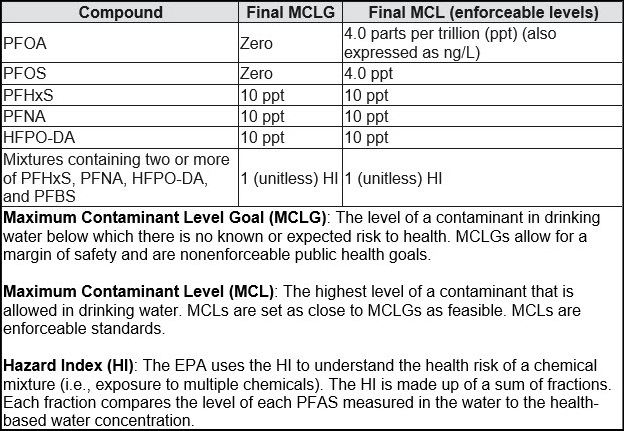On April 10, 2024, the Environmental Protection Agency (EPA) issued its final National Primary Drinking Water Regulation, establishing near-zero maximum contaminant levels (MCLs) for six per- and polyfluoroalkyl substances (PFAS). The new regulations establish the agency’s first-ever national, legally enforceable drinking-water standards for these “forever chemicals.”
What Are PFAS?
PFAS are manufactured chemicals that are resistant to heat, water, and oil. These properties have made PFAS ideal for use in a broad range of industries, including the automotive, aerospace, apparel, building and construction, electronics, medical, mining, oil and gas, and semiconductor industries.
Many PFAS are present at low levels in commercial, industrial, and consumer products, and in the environment. PFAS’ widespread use and low levels pose challenges for studying and evaluating the substances’ potential health and environmental risks.
What Is the New Rule?
In the final rule, the EPA is setting individual legally enforceable MCLs for five individual PFAS: PFOA, PFOS, PFNA, PFHxS, and HFPO-DA (known as GenX chemicals). The rule also applies to PFAS mixtures containing at least two or more of PFHxS, PFNA, HFPO-DA, and PFBS by using a hazard index (HI) MCL to account for the combined and co-occurring levels of these PFAS in drinking water. The EPA issued health-based, nonenforceable maximum contaminant level goals (MCLGs) for these PFAS.
The MCLs and MCGLs are expressed in parts per trillion (ppt). One ppt is equivalent to one drop of ink in the water contained in 20 Olympic-size swimming pools.

Water systems must take action to reduce the levels of these PFAS in drinking water if the level exceeds regulatory standards.
Regulated public water systems have three years to complete their initial monitoring for the chemicals. Systems must include their results in their annual water quality reports to customers.
Systems that detect PFAS above the new standards will have five years to implement solutions that reduce PFAS in their drinking water. Water systems must also notify the public if levels of regulated PFAS exceed the new standards.
How Will the Rule Impact Businesses?
Although the MCLs are not enforceable for regulated public water systems until 2029, regulators will likely expect businesses to use these near-zero MCLs when evaluating the extent of PFAS contamination in groundwater. Many state site cleanup programs use MCLs as cleanup levels for groundwater.
The MCLs and MCLGs will also impact the remediation of contaminated sites under the Comprehensive Environmental Response, Compensation, and Liability Act of 1980 (CERCLA).
Under CERCLA, Superfund remedies must achieve MCLGs when remediating groundwater and other drinking-water sources. Further, CERCLA requires that on-site remedial actions attain or waive federal environmental applicable or relevant and appropriate requirements (ARARs), or more stringent state ARARs, upon completion of the remedial action. No separate rulemaking or other process is required.
Once the rule takes effect, the new MCLs will become ARARs at the over 1,300 Superfund sites across the United States. This could result in increased cleanup costs, cleanup delays, and the expansion of existing Superfund sites to include PFAS and new responsible parties.
We expect to see an uptick in litigation. Water districts may bring more lawsuits against other parties to cover the costs of complying with the new standards, even with available federal funding.
Plaintiffs will certainly rely on the MCLs and MCLGs in nuisance, trespass, and toxic tort lawsuits. These plaintiffs may also rely on the EPA’s carcinogenicity findings for certain PFAS even though the EPA has provided tepid support for the findings.
Companies should begin evaluating how the final rule could impact their operations and create risk.
You can subscribe to future advisories and other Alston & Bird publications by completing our publications subscription form. If you have any questions, or would like additional information, please contact one of the attorneys on our Environment, Land Use & Natural Resources team.

